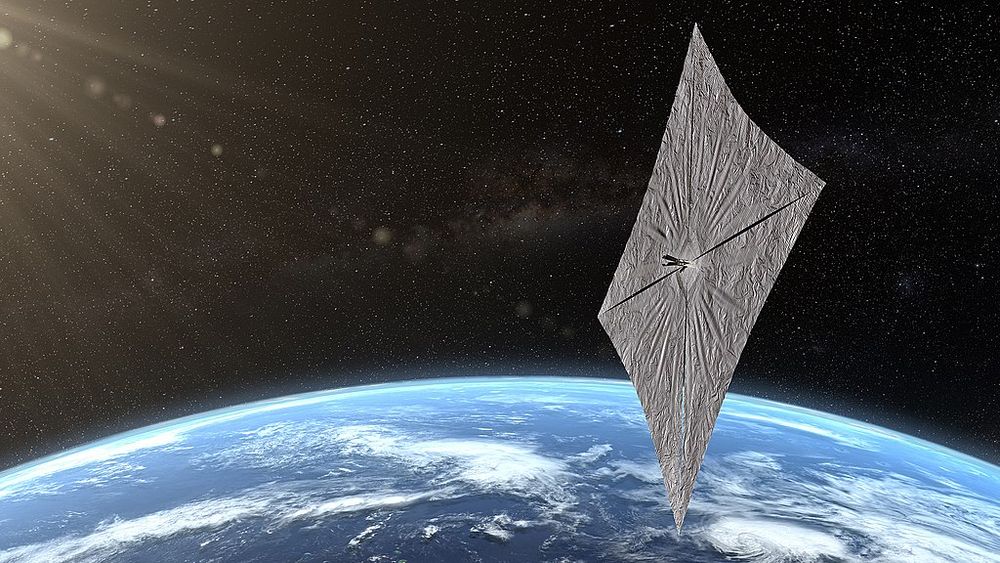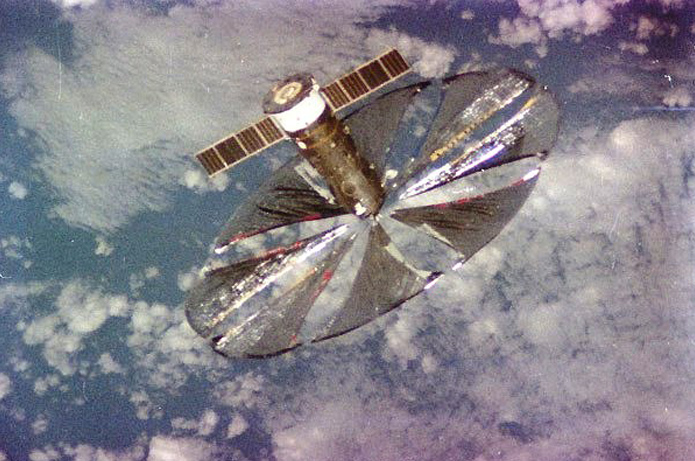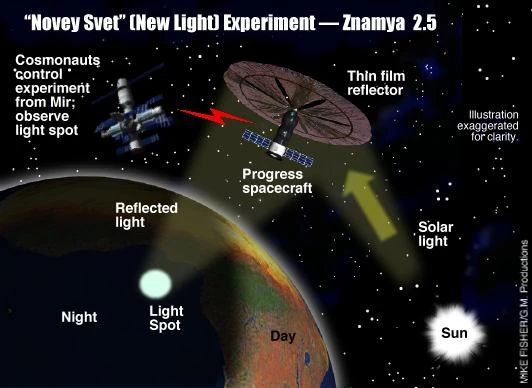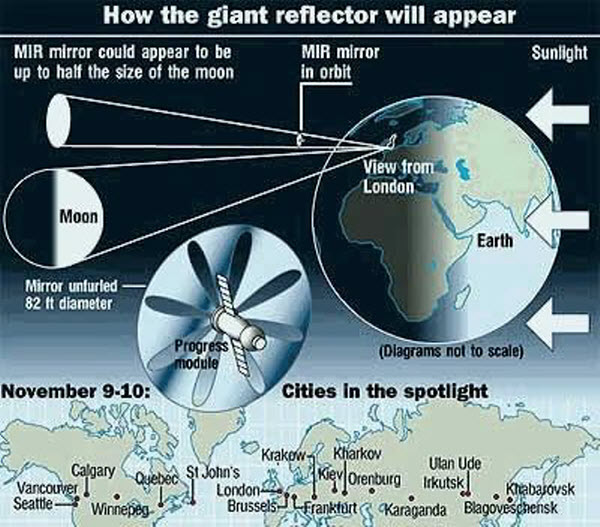
For a few hours just before dawn on the night of 4 February 1993, a giant spotlight, 5 kilometers in diameter, raced across Europe from west to east, before disappearing into the morning light of Byelorussia. Those who were on the beam’s sweep reported seeing a momentary flash of pale silvery light.
The spotlight came from a large reflector that was launched into orbit by the Russian Federal Space Agency, some three months earlier from Baikonur Cosmodrome. Called Znamya, which means “banner” or “flag” in Russian, the satellite was an experiment to study the feasibility of using space mirrors to illuminate the nightside of the planet using the sun’s rays, pretty much the same “way a schoolchild playing with a hand mirror learns to reflect a spot of light from a bright window into the crannies of his room,” as The New York Times explained in a 1993 article.
The idea of using space mirrors was first proposed by German physicist Hermann Oberth in 1929 for a much diabolic purpose. Oberth wanted to create a weapon, using a 100-meter-wide concave mirror, that could reflect sunlight onto a concentrated point on earth capable of incinerating whole cities and even boil oceans. The Nazis initially showed great interest on this so-called “sun gun” but later decided that there were easier ways to burn cities and nobody would benefit from a boiling ocean.
The concept was mostly forgotten, until half a century later, in the late 1980s, Soviet engineer Vladimir Sergeevich Syromyatnikov saw an opportunity in space mirrors to further his interest in solar sails.

An artist’s concept of a solar sail. Image credit: Josh Spradling / The Planetary Society
Syromyatnikov was a brilliant engineer who made his mark on the Russian space program by designing the docking system that enabled Soviet and American space capsules to link with each other during the Apollo-Soyuz missions—the first joint US–Soviet space flight. His designs are still used in the shuttles that dock at the International Space Station. Vladimir Syromyatnikov also helped design and develop Vostok, the world’s first manned spacecraft, which launched Yuri Gagarin into outer space in 1961.
Syromyatnikov developed an interest in solar sails, a method of spacecraft propulsion that uses the radiation pressure from the sun and distant stars to travel through space, just like a sailing ship harnesses the power of winds to sail the seas. Solar sails are required to be huge because radiation pressure is extremely weak, and only an enormous sail could generate enough force to propel a spacecraft forward at appreciable speeds. An 800 by 800 meter solar sail, for example, could take a 2-ton cargo to Mars in 400 days.
The idea of solar sail is fascinating, but the Soviet leaders at that time were more absorbed in earthly matters, especially how to increase the productivity of workers. Stalin once abolished weekends to increase industrial output, but that’s another story for another time.

Actual photograph of the Znamya 2 space mirror.
In order to drum up interest in solar sails, Syromyatnikov proposed that large reflective sails could be used to redirect sunlight back towards the Earth to illuminate cities and farmlands, especially in the perpetually dark polar regions, enabling workers and farmers to work after sundown. Syromyatnikov reasoned that this could reduce energy cost for electrical lighting, and extend twilight hours during planting and harvesting seasons to aid farmers. It could also help in rescue and recovery operations after natural disasters like earthquakes and hurricanes.
Related: The Giant Sun Mirrors of Rjukan
In October 1992, the space rocket Progress M-15 took off from Baikonur Cosmodrome and placed into orbit the satellite Znamya 2. After remaining attached to the Mir space station for three months, on 4 February 1993, Znamya 2 undocked and deployed a Mylar reflector, 20 meters across. The satellite was given a slow spin so that centrifugal forces would keep the reflector unfurled, since it had no support frame. And the mirror worked. In the early hours, just before sunrise, a dimly-lit spot of light about 5 km in diameter raced across the surface of the earth at 8 kilometers per second, starting at southern France through Switzerland, Germany, Czech Republic, Poland and finally disappeared in the early sunlight in Byelorussia. Unfortunately, the weather was cloudy that day and there were not many ground witnesses. The brightness of the spotlight also turned out to much less that expected—about as bright as the full moon.
The experiment lasted only a few hours, after which the satellite was de-orbited and it burned up in the atmosphere.


The success of Znamya 2 gave a new impetus to the Znamya program, and Soviet scientists began to plan bigger. A second launch was scheduled for 1999. Znamya 2.5 was to carry a slightly bigger sail (25 meters in diameter), was expected to shine brighter (up to ten full moons), cast a larger beam of light (7 kilometers across), and most importantly, keep the spotlight shinning at a fixed spot on earth for several minutes at a time. If that succeeded, Znamya 3 would launch a 70-meter mirror, and eventually the program would encompass a string of satellites placed in sun-synchronized orbits, each carrying 200-meter mirrors and each having the capacity to illuminate a ten-square-mile area on earth with a brightness nearly 100 times greater than moonlight. The idea was essentially to bend night into day.
Unfortunately, Znamya 2 failed. When the sail was unfurled, the fabric got caught on one of Mir’s antennae and the delicate sail got ripped. With Russia’s finances already in taters after the break of the Soviet Union, the government decided that it didn’t have the budget to support scientific researches, and the mission was scrapped.
References:
# Vice, https://www.vice.com/en_us/article/9a3y8d/the-man-who-turned-night-into-day
# https://www.qsl.net/dg7ro/afu/mir_news/isslight.htm
# NY Times, https://www.nytimes.com/1993/01/12/science/russians-to-test-space-mirror-as-giant-night-light-for-earth.html
# Triz Journal, http://triz-journal.com/space-mirror/



Comments
Post a Comment